As an Amazon Associate I earn from qualifying purchases.
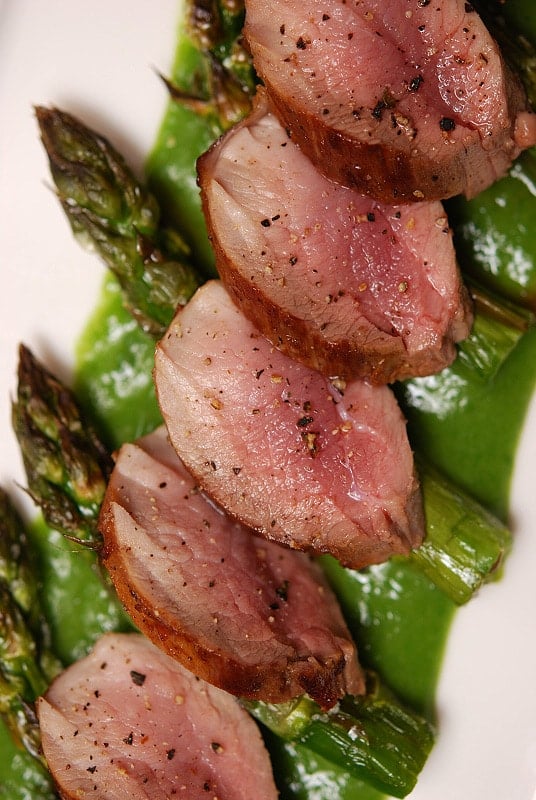
This dish is my little way of protesting an opinion piece that appeared in the New York Times recently suggesting that eating free-range pork poses a significant health risk compared to swine raised in factory farms — and as an aside mentioned how foolish it is to eat pork that is cooked below the incineration point.
Without getting into the politics of it too much (I weigh in on the discussion here, and there is a good back-and-forth here, starting with the author’s rejoinder — NOTE: I am not the “hank” in the comments of the Atlantic piece.), suffice to say I do not subscribe to the author’s belief. I like my pork done medium. And in this case, I like my wild boar tenderloin medium.
Let me first say that the risk of picking up trichinosis by eating wild boar (and especially bear) is real — far more real than that in free-range hogs. Let me say next that this real risk is still very, very small: If you ate fresh, rare boar, it’s still less than one in a hundred, according to most research I’ve read. Bear, by the way, is higher. I don’t eat bear (for lots of reasons).
Now let me say that one-in-a-hundred is still too risky for me, as the symptoms of trichinosis are no fun. So how can I eat pink pork? Easy. Most of my wild boar is frozen hard in a box freezer that gets close to zero degrees Fahrenheit; this will kill the parasites.
Second, pink pork is still cooked hotter than the little wormy things can bear. If you are like me and like medium pork, shoot for a temperature of at least 140 degrees, and better yet 145-150. (Trichinae worms die at 137 degrees). Let me finish by saying that I have never seen any evidence of parasites in any meat Holly or I have brought home, although I did find worms in a few jacksmelt I caught at Bodega Bay last year.
On to this dish, which to me stamps the season perfectly right now: Asparagus and green garlic are in full swing, so we are gorging ourselves on it while we wait for sugar peas and fresh fava beans. As for the boar, it seems to me like a lighter meat to transition from Red Meat Winter into White Meat (and Fish) Summer.
The boar tenderloin is salted, seared simply in sweet butter and then rested and sliced. The asparagus is coated in olive oil, salted and broiled until it just starts caramelizing.
Which leaves the green garlic sauce. Definitely the star of the dish. I rely heavily in my sauce-making on a technique I learned from the The French Laundry Cookbook where you blanch a vegetable, puree it, push it through a fine-mesh sieve or tamis, and cook it gently with a little butter or salt. Chef Thomas Keller does this with parsley. I do it with lots of things.
And yes, it is time-consuming. But very worth it. The resulting sauce has enormous body, a gentle garlic-onion flavor and a richness that can only come from sweet butter.
Wild Boar Loin with Asparagus
Ingredients
- 1 pound pork tenderloin
- 2 tablespoons unsalted butter, divided
- Kosher salt
- 1 pound asparagus
- 1 tablespoon olive oil
- 6 green garlic stalks
- 3 green onions
Instructions
- Make the sauce. Get a large pot of water to a boil, and salt it well. it should taste like the sea. Blanch the green garlics and onions, white part down — hold them by the greens in the boiling water for 3-4 minutes. I suppose you could chop them in half and then blanch the two parts separately, but I have not tried this. After the white ends have been in for 3-4 minutes, toss the rest in and let it all boil for 2 minutes.
- Remove and dump into a large bowl of ice water to cool. Take the veggies out and chop roughly. Put the green onions and green garlics into a food processor and buss the hell out of them, scraping down the sides from time to time. It will take a bit of doing to incorporate, but you will eventually get a bright green puree.
- Now the hard part. Push the puree through a tamis or fine-meshed sieve. This will take some effort. Take your time and keep at it for about 10 minutes or so, or until there are only fibers in the mesh. Save the strained puree for now.
- Salt the pork pieces well and set aside. Turn on the broiler.
- Using the tablespoon of olive oil, coat the asparagus well and then salt them. Put one tablespoon of butter in a saute pan set on high heat. When the butter melts, turn the heat down to medium-high.
- Put the asparagus under the broiler. Saute the boar tenderloin over medium-high heat, turning to hit all sides. You are looking for medium here — just a blush of pink. When the tenderloins are about done, remove the asparagus (the timing should work out.)
- Pour the green onion/garlic puree into a small pot and add the other tablespoon of butter, set of medium-low heat and swirl to combine. Do not let this boil. Add salt to taste.
- Let the boar rest while the sauce heats up. The second the sauce begins to bubble, turn off the heat and lay down some sauce on the plate. Top with the asparagus, and then with the tenderloin cut thinly.
Nutrition
Nutrition information is automatically calculated, so should only be used as an approximation.
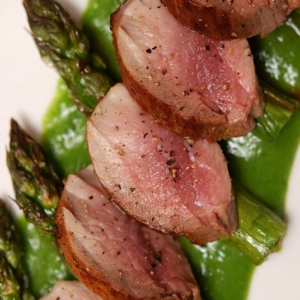
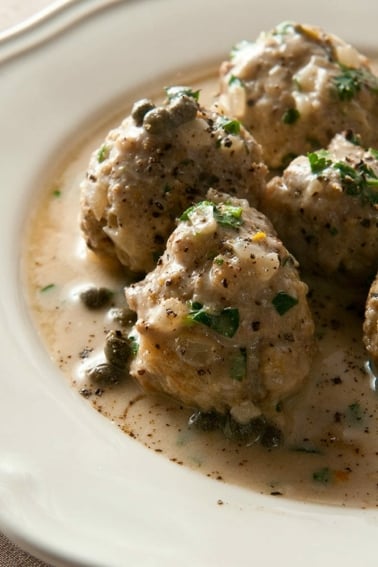
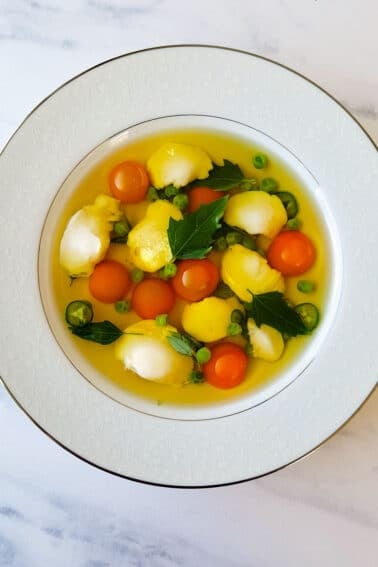
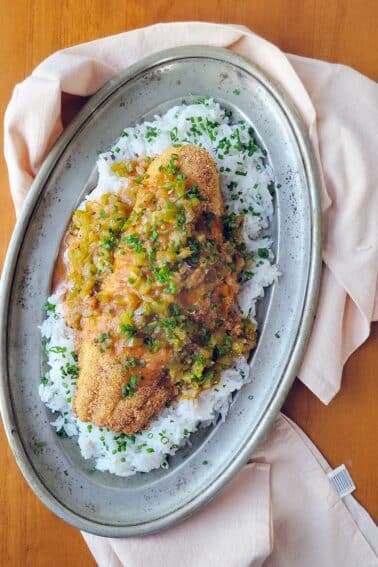
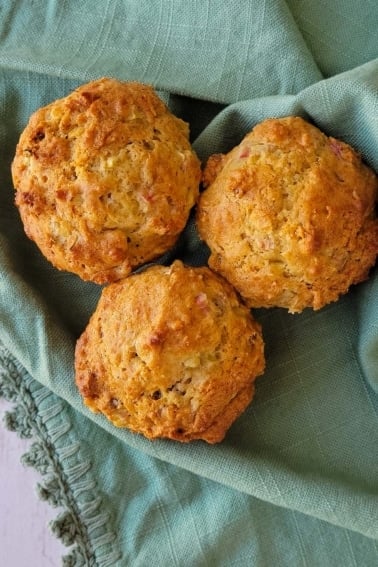
Just got my hands on a couple of back straps and I really want to try this recipe.
I have a question though: I can’t find green garlic stalks anywhere. Can I substitute them with something else or maybe use some garlic cloves instead?
Kristine: Maybe garlic chives? Failing that, yes, just use regular garlic.
I will definitely try to cook that! 🙂
Sportingdays girl: Yep, I’ve seen them in the farmer’s market, but the sugar peas are still $4 a pound and the favas are still too small…
And what you’re suggesting, Chef Apprentice, is an Italian salsa verde — great with grilled meat. This time I wanted something more…refined…Can I help it if I want to git all fancy Frenchy pants every once and again?
Hank, what’s with you getting all French Laundrified? Just take that green garlic, slice it up then, stick it in a mortar with olive oil and salt, grind it all up and toss it on your lovely meat.
Thanks, Hank, for the good, sensible discussion of the issue and for the wonderfully delicious sounding recipe. We should have green garlic here in a few more weeks. We’ll count the days!
It’s always good to know the facts instead of someone else’s version of the distorted facts!
The dinner sounds and looks incredible. Just imagining first bite is good enough. BTW – I’m sitting outside eating handfuls of snap peas for lunch — farm stand fresh, probably picked this morning while I was making coffee. “They’re heeeeeere….”
I need to hunt down some green garlic, that sauce sounds just too damn good.
I’m happy to see you weigh in on this Hank. I’ll be the first to admit that dealing with politics as a whole is unsavory, but sometimes speaking out is important. You were the first person I thought of when I was sent that NYTimes piece, and now I feel better knowing for sure that it was full of bunk.
There is a nice piece refuting the Times’ piece in the April 15 Huff Post. Sorry I haven’t got the time to find the link for you. Your dish sounds wonderful!
If you do dry cure, as I do, you take care to freeze the meat long enough and at a low enough temperature. My chest freezer is set for
-20, measured.
Even if you want to cook pork to well done, which I haven’t wanted to do in years, free range is tastier.
The third from last picture on this blog post is a piece of beef siitting next to a piece of pork from a slow food butcher. Dietrich’s.
https://blog.charcuteire.com/2008/04/14/meet-the-meat.aspx
I read that piece — which was in favor of meat for the masses, but against both factory farming and pasturing, and with no solution for how to provide that meat. I couldn’t agree with you more. Pork tastes completely different cooked to pink, and though trichnosis is a problem (if a treatable one), most meat is cooked to high enough temps before ingestion. Good point on freezing, too.
Good to see someone defending pork cooked to temperature. Beautifully cooked I might add.